Embarking on the journey to truly understand your customers can transform the way your business operates and how it is perceived in the marketplace.
Utilizing a customer satisfaction survey is a key strategy in this journey, offering direct insights into the customer experience, their journey, and overall sentiment towards your brand.
Whether you’re looking to measure customer satisfaction, gauge the effectiveness of your customer service, or fine-tune your product offerings, the right questions can reveal a wealth of information.
In this blog, we will dive deep into the art and science of crafting effective customer surveys. We’ll explore the essential questions to ask that measure the straightforward customer satisfaction score and unravel the nuanced layers of customer sentiment throughout their journey.
From first contact to post-purchase, understanding these aspects will empower you to make informed decisions that enhance customer experiences and drive loyalty. Let’s get started on how to harness the power of customer feedback to propel your business forward.
What are Customer Satisfaction Surveys?
Customer satisfaction surveys are one of the top help desk metrics and are like a direct line of communication between a business and its customers.
Imagine you’ve just had a meal at a restaurant, and the manager comes over to ask how everything was. That’s essentially what a customer satisfaction survey does but in a more structured way.
These surveys are made up of questions that customers can answer, usually on a scale from “very unsatisfied” to “very satisfied.”
The questions might cover things like the quality of the product or service, the friendliness of the staff, the speed of service, or the overall experience.
Why Customer Satisfaction Surveys are Important?
Now, you might wonder, why companies bother with these surveys. Well, they’re super important for a few reasons:
- Feedback: They give businesses valuable feedback on what they’re doing right and what they need to improve. It’s like getting a report card that tells you what subjects you’re acing and where you might need a bit of extra help.
- Customer Voice: They give customers a voice. It’s a way for you to tell the company directly what you think, which can be satisfying, especially if you’ve had a particularly good (or bad) experience.
- Improvement: They help businesses improve. By identifying areas where customers aren’t happy, companies can make changes to enhance the customer experience.
- Loyalty: They can boost customer loyalty. If a company listens to its customers and makes changes based on their feedback, customers are likelier to stick around.
- Reputation: They can help with a company’s reputation. Happy customers are more likely to spread the word about their positive experiences, which can attract new customers.
In a nutshell, customer satisfaction surveys are a win-win: customers get to have their say, and businesses get valuable insights that can help them grow and improve.
Types of Customer Satisfaction Survey and Templates
There are several types of customer satisfaction surveys, each designed to gather specific types of feedback. Here’s a breakdown:
1. Net Promoter Score (NPS) Surveys
Net Promoter Score surveys ask customers how likely they are to recommend your product or service to others on a scale of 0 to 10. Based on their responses, customers are categorized as promoters, passives, or detractors. NPS surveys are great for measuring overall customer loyalty.

2. Customer Satisfaction (CSAT) Surveys
These surveys ask customers to rate their satisfaction with your product, service, or a specific interaction. Typically, the rating is on a scale, such as 1 to 5 or 1 to 10. CSAT surveys are useful for getting a snapshot of customer feelings at a particular moment.

3. Customer Effort Score (CES) Surveys
These surveys measure how easy it is for customers to interact with your company. For example, they might rate how easy it was to get a problem resolved or to make a purchase. CES surveys are great for identifying areas where you can reduce customer effort and improve the experience.
For industries where verifying customer eligibility is crucial, understanding what is age verification can help reduce friction and enhance the overall experience.
4. Star Rating Survey
Star rating surveys are a popular and intuitive method for capturing customer feedback on a variety of topics, ranging from product satisfaction to service experiences. These surveys typically ask respondents to rate aspects of their experience on a scale, most commonly from one to five stars, with one star representing very poor and five stars representing excellent.

100 Customer Satisfaction Survey Questions
Creating an effective customer satisfaction survey involves asking the right questions to gather comprehensive insights into various aspects of your business. Here’s a detailed list of questions you can include in different categories:
General Satisfaction
- How would you rate your overall satisfaction with our products/services?
- How likely are you to return to our business?
- How likely are you to recommend our products/services to others?
- How does our service compare to other companies you have used in the past?
- How well do our products/services meet your needs?
- What aspect of our products/services were you most satisfied with?
- What would you improve about your overall experience?
- How do you rate the value for money of our products/services?
- How well do our products/services stand out from our competitors?
- How likely are you to purchase from us again based on your overall experience?
Product Specific
- How would you rate the quality of our product?
- Did our product meet your expectations?
- How well does our product meet your needs?
- How do you rate the design and functionality of our product?
- How likely are you to purchase this product again?
- What features do you like most about our product?
- What features do you think need improvement?
- Was there anything about the product that surprised you (positively or negatively)?
- How does this product compare to similar products in the market?
- Would you consider our product a good investment?
Service Specific
- How satisfied are you with the speed of our service?
- How would you rate the professionalism of our staff?
- Were our staff members helpful and courteous?
- How effectively did our staff answer your questions?
- How do you rate the accessibility of our service?
- How personalized was the service you received?
- Did our staff show adequate knowledge about the services?
- Were there any problems with the service provided, and how were they handled?
- How likely are you to use our services again?
- How do our services compare to those you’ve experienced elsewhere?
Customer Support
- How satisfied are you with the resolution of your issues?
- How quickly were your issues resolved?
- Was our customer support team easy to reach?
- How knowledgeable did our support team seem?
- How well did our customer support team understand your needs?
- Were you satisfied with the solutions provided by our support team?
- How many interactions did it take to resolve your issue?
- How would you improve our customer support?
- How likely are you to contact our customer support in the future?
- Did our customer support follow up with you after resolving your issue?
Pricing
- How do you feel about the value of the price you paid?
- Do you think our products/services are priced fairly?
- How likely are you to continue using our products/services based on the price?
- How do our prices compare to those of our competitors?
- How satisfied are you with the discounts and offers we provide?
- How clear and understandable are our pricing structures?
- Do we offer a good range of pricing options for different needs?
- How well do we communicate any price changes or updates?
- Do you feel the price you paid reflects the quality of the product/service?
- Considering the pricing, how likely are you to choose our products/services again?
Website/Online Experience
- How easy is it to navigate our website?
- How satisfied are you with the online purchasing process?
- How well does our website meet your needs?
- How do you rate the loading speed of our website?
- How secure and convenient do you find the online payment process?
- How accurate and helpful is the information provided on our website?
- How would you rate the mobile-friendliness of our website?
- How effective is our customer support when shopping online?
- How easy is it to find the information you need on our website?
- How personalized do you find your browsing experience?
Delivery/Shipping
- How satisfied are you with the delivery time?
- Was your product delivered in good condition?
- How would you rate the accuracy of your order?
- Are you satisfied with the variety of shipping options available?
- How satisfactorily were any issues with damaged goods handled?
- How accurate and timely was the tracking information provided?
- How well did we communicate throughout the delivery process?
- How do you rate the quality of the packaging of your delivered items?
- How easy is it to arrange returns or exchanges?
- How do you feel about the cost of shipping and handling?
Feedback and Improvements
- What do you like most about our products/services?
- What changes would you suggest to improve our products/services?
- Is there anything we can do to enhance your experience?
- In what areas did we meet or exceed your expectations?
- In what areas did we not meet your expectations?
- How often do you use our products/services?
- How can we improve our customer service?
- What other products or services would you like us to offer?
- Would you like us to follow up with you about your feedback?
- How can we better engage with our community?
Demographic Questions
- What is your age range?
- What is your gender?
- Which region or country are you from?
- What is your highest level of education?
- What is your employment status? (Employed, self-employed, student, retired, etc.)
- Which industry do you work in?
- What is your household income range?
- What is your marital status?
- How many people live in your household?
- Do you have children under the age of 18?
Additional Questions
- How did you first hear about us?
- What factors influenced your decision to purchase from us?
- Are there any other products or services you wish we offered?
- What specific feature attracted you to our product/service?
- How frequently do you use our product/service?
- How do you primarily use our product/service? (Personal, business, etc.)
- What is your preferred method of communication for receiving updates and promotions from us? (Email, text, social media, etc.)
- Have you recommended our products/services to others? If so, why?
- What would make you more likely to use our product/service more frequently?
- Is there anything that nearly stopped you from buying our product/service?
These questions will help you gather deep insights into customer satisfaction across various facets of your business. Tailor these questions to fit your specific needs, and remember to analyze the results to make meaningful improvements in your product offerings and customer service strategies.
Discover How Desk365 can Transform your Reporting and Tracking Metrics Easier.
By automating ticket management and providing detailed analytics, Desk365 empowers you to swiftly address customer issues and improve satisfaction rates.
Benefits of Customer Satisfaction Survey
Customer satisfaction surveys are like the secret sauce for businesses, providing a bunch of benefits that can make a difference. Here’s why they’re so great:
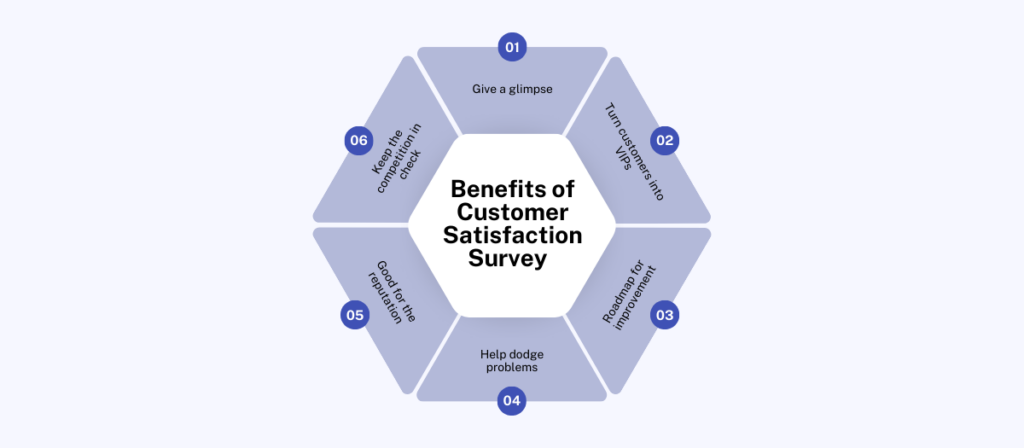
- Give a glimpse: Surveys give businesses a glimpse into what customers are thinking and feeling. They show what’s working well and what needs a tweak.
- Turn customers into VIPs: When customers get a chance to share their thoughts, they feel valued and important. It’s like rolling out the red carpet for them, which can make them more loyal to the brand.
- Roadmap for improvement: The feedback from surveys is like a roadmap that guides businesses on what to improve. Whether it’s speeding up service or enhancing product quality, surveys point out the areas that need attention.
- Help dodge problems: By catching issues early on, surveys can help businesses avoid bigger problems down the line. It’s like having a heads-up that there’s a pothole ahead, so you can steer clear before it causes any damage.
- Good for the reputation: Happy customers are more likely to spread the word about their positive experiences. Surveys can help businesses keep customers happy, which is great for their reputation.
- Keep the competition in check: By continuously improving based on survey feedback, businesses can stay ahead of the competition. It’s like being in a race and having a turbo boost that keeps you in the lead.
Best Practices for Customer Satisfaction Survey
When it comes to customer satisfaction surveys, there are some best practices to keep in mind to ensure you get the most useful and actionable feedback. Here are ten tips:
- Keep it Short and Sweet: Nobody likes a long, tedious survey. Aim for a concise survey that takes no more than 5-10 minutes to complete. This respects your customers’ time and increases the likelihood of them completing the survey.
- Be Clear and Specific: Make sure your questions are straightforward to understand. Avoid jargon or ambiguous language that might confuse respondents.
- Use a Mix of Question Types: Incorporate a variety of question types, such as multiple-choice, rating scales, and open-ended questions. This keeps the survey interesting and allows you to gather different types of feedback.
- Start with Important Questions: Place the most critical questions at the beginning of the survey. Respondents are more likely to answer these when they’re fresh and not fatigued from answering other questions.
- Ensure Anonymity: Assure respondents that their responses are anonymous. This encourages honesty and increases the reliability of the feedback.
- Use Skip Logic: If your survey tool allows it, use skip logic to direct respondents to relevant questions based on their previous answers. This makes the survey more personalized and relevant to each respondent.
- Test Your Survey: Before sending it out to your entire customer base, test the survey with a small group. This helps you identify any confusing questions or technical issues.
- Offer Incentives: Consider offering a small incentive, such as a discount or entry into a prize draw, to encourage participation.
- Follow Up on Feedback: Let your customers know that their feedback has been heard and, if possible, outline any changes you plan to make based on their suggestions. This builds trust and shows that you value their input.
- Analyze and Act on the Data: Once you’ve collected the responses, take the time to analyze the data and identify areas for improvement. Then, create an action plan to address these issues.
By following these best practices, you can design a customer satisfaction survey that provides valuable insights and helps you improve your business.
Real-Life Examples of Customer Satisfaction Survey
Let’s take a look at some real-life examples of customer satisfaction surveys from different companies:
Apple's Product Feedback Survey
Apple often sends out surveys after you purchase a product. They might ask how satisfied you are with the product’s design, performance, and features. They also typically include open-ended questions where you can provide more detailed feedback.
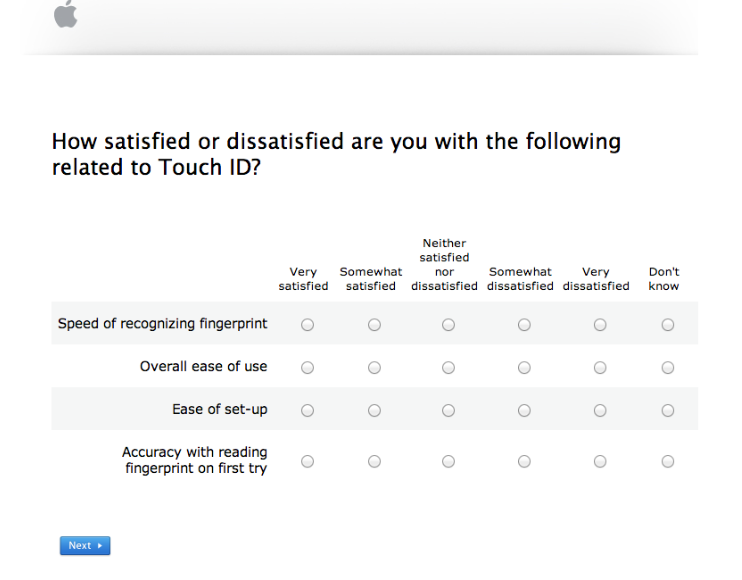
Airbnb's Stay Feedback Survey:
After staying at an Airbnb, guests are asked to rate their experience in several areas, including cleanliness, accuracy of the listing, communication with the host, and overall satisfaction with their stay.
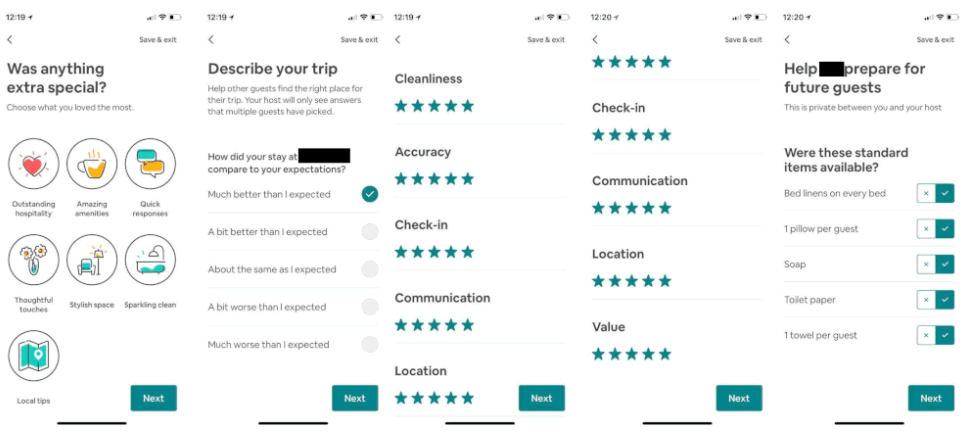
Uber's Ride Feedback Survey:
After a ride with Uber, passengers are prompted to rate their experience with the driver, the cleanliness of the vehicle, and the overall ride experience. They can also leave additional comments if they wish.
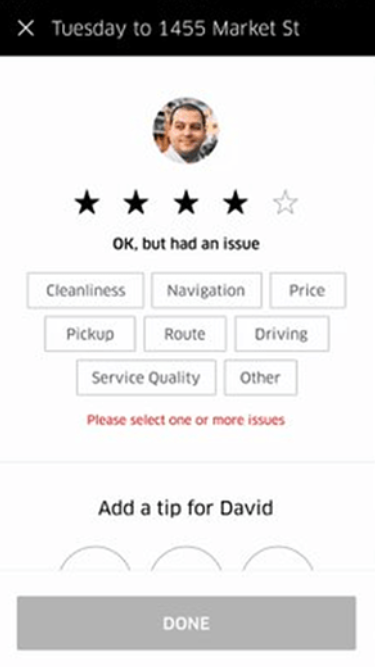
Netflix's Viewing Experience Survey
Netflix sometimes sends surveys to gather feedback on their streaming service. They might ask about the quality of the streaming, the variety of content available, and the ease of use of their platform.
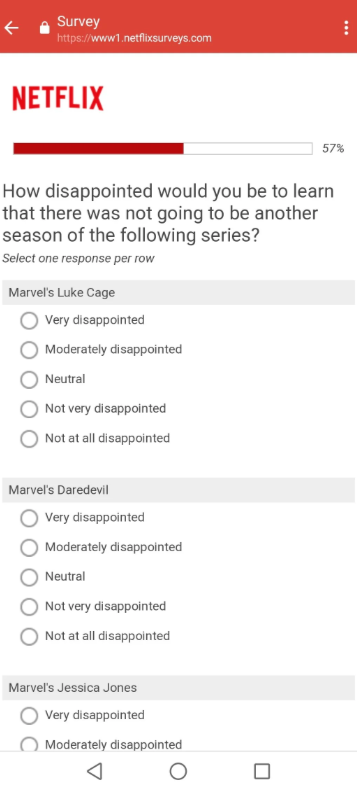
How To Use Customer Satisfaction Survey Results
Understanding how to use customer satisfaction survey results effectively is crucial for any business looking to improve its products, services, and overall customer experience. Here’s a conversational breakdown of how you might go about it:
1. Analyze the Data: First things first, you need to sift through the survey results. Look for patterns or common themes in the responses. This could involve quantitative data like ratings and scores, or qualitative data like open-ended responses. Tools like spreadsheets or more advanced data analysis software can help you visualize trends and outliers, making the data easier to understand.
2. Share the Insights: Once you have a grasp of the data, share your findings with your team. This isn’t just for top management; sharing with everyone from customer service reps to product developers can foster a broader understanding of customer needs and how each department plays a role in meeting them.
3. Set Actionable Goals: With the insights in hand, set practical, achievable goals. For instance, if customers are dissatisfied with response times, a goal might be to reduce response times by 20% in the next quarter. Make sure these goals are specific, measurable, achievable, relevant, and time-bound (SMART).
4. Implement Changes: This is where the rubber meets the road. Depending on the feedback, changes could be small or large—from tweaking your website’s FAQ to overhauling your product return policy. It’s important to prioritize changes based on what will most significantly impact customer satisfaction and business operations.
5. Follow Up: After implementing changes, don’t just assume everything’s fixed. Follow up with customers, either through another survey or through direct communication methods like emails or social media. This not only shows customers that you value their feedback but also gives you data on whether the changes have had the desired effect.
6. Celebrate Improvements and Reflect on the Process: If survey results show improvement, celebrate! This boosts morale and encourages a continuous focus on customer satisfaction. If results aren’t as positive as expected, take it as a learning opportunity. Reflect on what might have gone wrong and adjust accordingly.
Using customer satisfaction surveys effectively means continuously learning from and responding to customer feedback. It’s an ongoing process that, when done right, can dramatically enhance how your business meets its customers’ needs and expectations.
Act on Survey Responses Effectively
As we wrap up our exploration of customer satisfaction surveys, it’s clear that the insights gleaned from these tools are invaluable for navigating the complexities of the customer journey.
By asking the right questions, businesses can tap into a deep well of information that reveals not just how customers feel about a product or service, but also why they feel that way.
The ultimate goal of any customer satisfaction survey should be to enhance the customer experience, thereby fostering greater customer retention and cultivating a base of loyal customers.
Each survey response serves as a guidepost on the customer journey, highlighting what your business is doing well and where there are opportunities for improvement.
Incorporating customer feedback into your business strategy isn’t just about fixing problems; it’s about reinforcing what you’re already doing well and making sure that your customers know their voices are heard.
This not only helps in retaining your current customers but also turns them into advocates for your brand. After all, a loyal customer who feels valued is your best salesperson.





